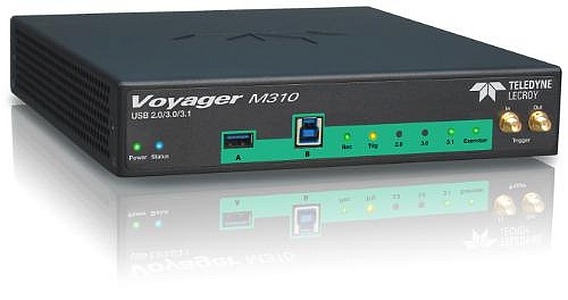- Teledyne LeCroy has released an upgrade for the Voyager USB analyzer platform with enhancements designed to provide 100% coverage of the required USB Power Delivery (PD) and USB Type-C™ functional compliance tests.
- The Voyager M310P is an USB 3.1 protocol analyzer with an exerciser system that now supports eye-diagram capture and bit-error-rate test functionality to provide one-stop verification for PD and USB Type-C compliance.
Teledyne LeCroy’s Voyager platform is an approved verification system for SuperSpeed USB 3.1 Link Layer and Hub compliance. The additional coverage of USB Type-C and USB PD compliance increases the number of test specifications addressed by the Voyager M310P to four.
The Voyager M310P now fully supports both USB PD 2.0 and USB PD 3.0 as well as Link Layer (Ch. 6 & 7) and Hub (Ch.10) compliance.
The Voyager M310P relies on built-in traffic emulation modes to perform the USB Power Delivery Compliance testing. The addition of eye-diagram capture and bit-error-rate test functionality extends the capabilities of the Voyager M310P to perform signal integrity testing on the USB PD Communications Channel (CC).
To complete the noise immunity tests, the Voyager M310P incorporates an arbitrary waveform generator (AWG) designed to generate an aggressor signal that closely matches the frequency spectrum of the USB 2.0 signal. These enhancements allow the Voyager M310P to fully support the USB-IF’s USB PD Compliance Plan as defined by the “PD Communications Engine” MOI.
In addition to the eye-diagram tests, the Voyager M310P also adds the USB Battery Charging (BC) 1.2 emulation mode required for specific USB Type-C compliance tests. The ability to source VCONN at 3V represents a new USB PD compliance check for Electronically Marked cables. The ability to source out-of-range of VBUS voltages (under 3.67V) is needed to verify that DRP devices correctly detect the un-attached state. The ability to sink VCONN current as low as 100 mW was added to verify source devices continue to provide VCONN current during suspend mode. Improved detection circuitry is required to verify devices properly enter the USB ‘safe-state’ on CC, SBU, and the USB 2.0 (D+/D-) lines. The analyzer mode of the Voyager M310P is also enhanced to support 4-lane DisplayPort signaling for USB Type-C devices that support Alternate Modes.






